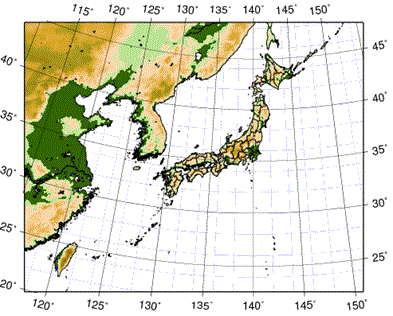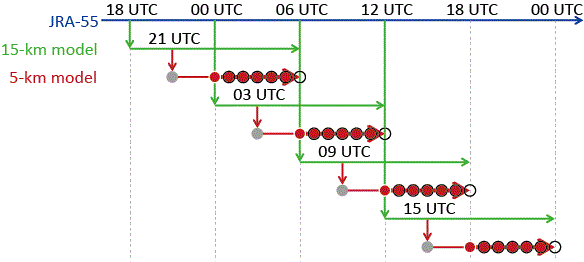Dynamical Regional Downscaling Using the JRA-55 Reanalysis
(DSJRA-55)
Regional downscaling using the Japanese 55-year Reanalysis (JRA-55) as initial and boundary conditions
Latest News
- 18 July 2017
- Official English website for Dynamical Regional Downscaling Using the JRA-55 Reanalysis (DSJRA-55) launched.
Overview of the Dynamical Regional Downscaling Using the JRA-55 Reanalysis (DSJRA-55)
Dynamical Regional Downscaling Using the JRA-55 Reanalysis (DSJRA-55) Downscaling method Source References
Dynamical Regional Downscaling Using the JRA-55 Reanalysis (DSJRA-55)
To help clarify climatic characteristics (such as trends of extreme phenomena) and support case studies on extreme meteorological events in Japan, the Japan Meteorological Agency (JMA) conducted DSJRA-55 (a regional downscaling based on the Japanese 55-year Reanalysis (JRA-55, Kobayashi et al. 2015) for initial and boundary conditions) for the period from 1958 to 2012 to produce a climate dataset with a horizontal resolution of 5 km that appropriately represents phenomena associated with Japan’s uneven terrain (Kayaba et al. 2016).
Downscaling method
The DSJRA-55 product is based on time integration from six-hourly JRA-55 analysis fields as initial conditions with the JMA operational Meso-Scale Model (MSM) as of November 2012 (JMA 2013).
These initial conditions do not incorporate cloud physics variables for the MSM. As certain integration hours are needed for the MSM to produce appropriate precipitation data from such initial conditions, there is a tendency for insufficient production of precipitation data at the beginning of forecast integrations. One way to circumvent this issue is to perform a spin-up run covering a period of three to six hours immediately after the start of forecasts. JRA-55 analysis fields, which have a horizontal resolution of 55 km, are also too coarse for the initial and boundary conditions adopted for the 5-km resolution MSM, and terrain differences would produce non-negligible noise in forecast fields. Thus, boundary conditions with intermediate resolution are necessary for areas in between. Accordingly, in DSJRA-55, the 15-km resolution MSM (as per the 5-km resolution MSM except with a horizontal resolution of 15 km) is first employed in the formulation of 12-hour forecasts from JRA-55 analysis fields. Next, 3- to 12-hour forecast fields are used as initial and boundary conditions for 9-hour forecasts based on the 5-km MSM. Data on the resulting 3- to 9-hour forecast fields are then provided in the form of the DSJRA-55 product (Figures 1 and 2). It should be noted that DSJRA-55 consists of 6 - 12 h forecasts with respect to the JRA-55 analysis, and may therefore contain forecast errors equivalent to those observed in 6 - 12 h forecasts of the operational MSM (JMA 2013).

Figure 1. The domain of MSM (5-km resolution)
Adapted from Kayaba et al. (2016).

Figure 2. Timelines illustrating the flow of DSJRA-55 calculation
References
- JMA, 2013: Meso-Scale Model (JMA-MSM1206). Outline of the operational numerical weather prediction at the Japan Meteorological Agency, JMA, Japan, 71-93.
- Kobayashi, S., Y. Ota, Y. Harada, A. Ebita, M. Moriya, H. Onoda, K. Onogi, H. Kamahori, C. Kobayashi, H. Endo, K. Miyaoka, and K. Takahashi, 2015: The JRA-55 reanalysis: general specifications and basic characteristics. J. Meteor. Soc. Japan, 93, 5-48.
Usage of DSJRA-55
JMA provides the DSJRA-55 product to users for research activities such as clarification of climatic characteristics (e.g., trends of extreme phenomena) and case studies on extreme meteorological events in Japan.
The DSJRA-55 product can be downloaded from the Data Integration & Analysis System (DIAS) of the Program to Promote the Development of Earth Environmental Information Platform.
Please note the following in regard to downloading data from DIAS:
- DIAS is a separate entity from JMA and is solely responsible for their own web portal and data access procedures.
- User registration and agreement to terms and conditions of data service usage are required at the DIAS web portal.
Data Integration & Analysis System (DIAS) of the Program to Promote the Development of Earth Environmental Information Platform
- Dynamical Regional Downscaling Using the JRA-55 Reanalysis (DSJRA-55) http://search.diasjp.net/en/dataset/DSJRA55
DSJRA-55 Product Users' Handbook
This handbook gives an overview of the DSJRA-55 product.
- July 2017
- DSJRA-55 Product Users' Handbook
Adobe Reader® must be installed to enable viewing of Portable Document Format (PDF) files.
Contact Us
Contact JMA at the email address below with any questions on DSJRA-55.
Numerical Prediction Division, Information Infrastructure Department, Japan Meteorological Agency- Questions on the DSJRA-55 product
- And other questions